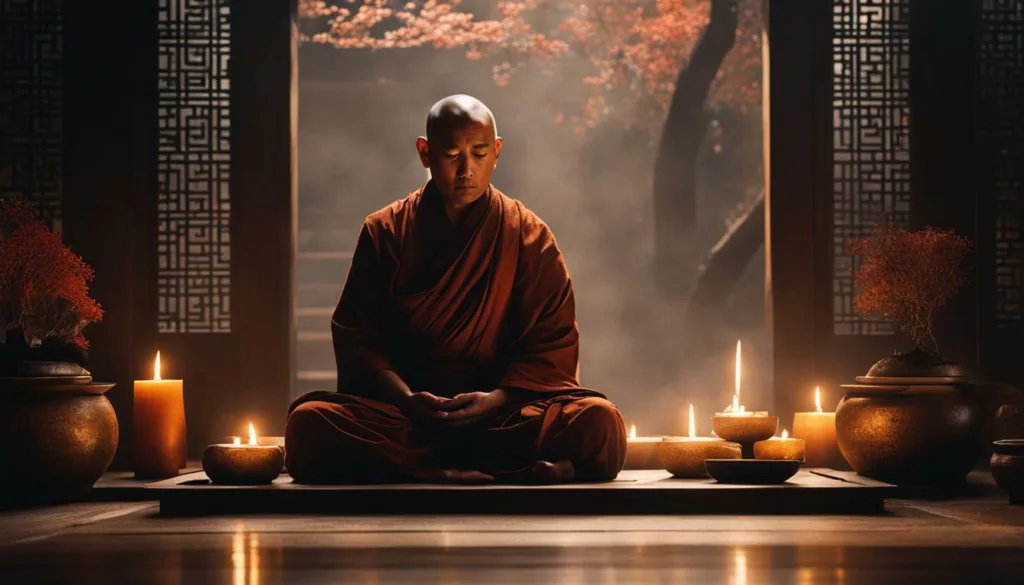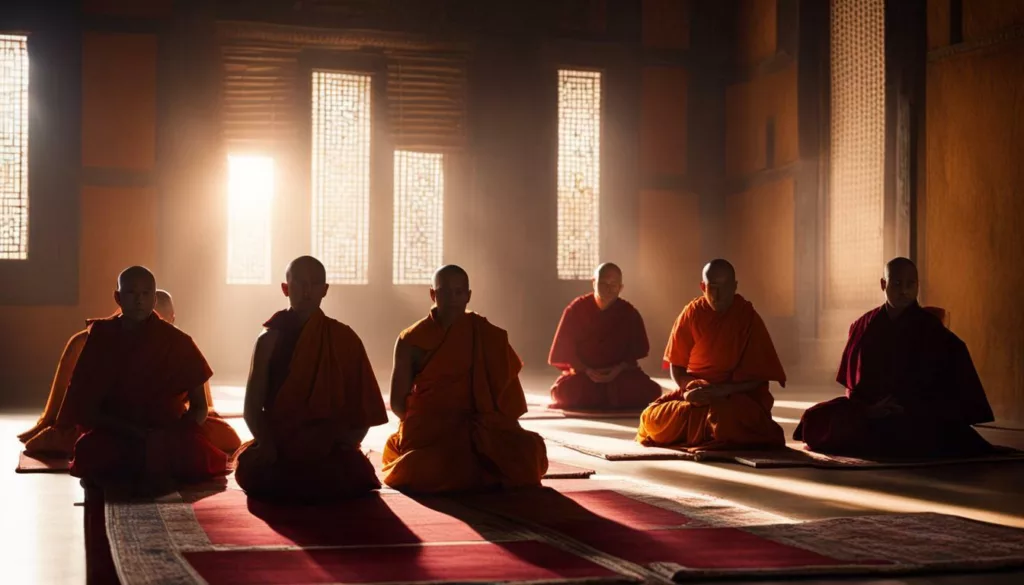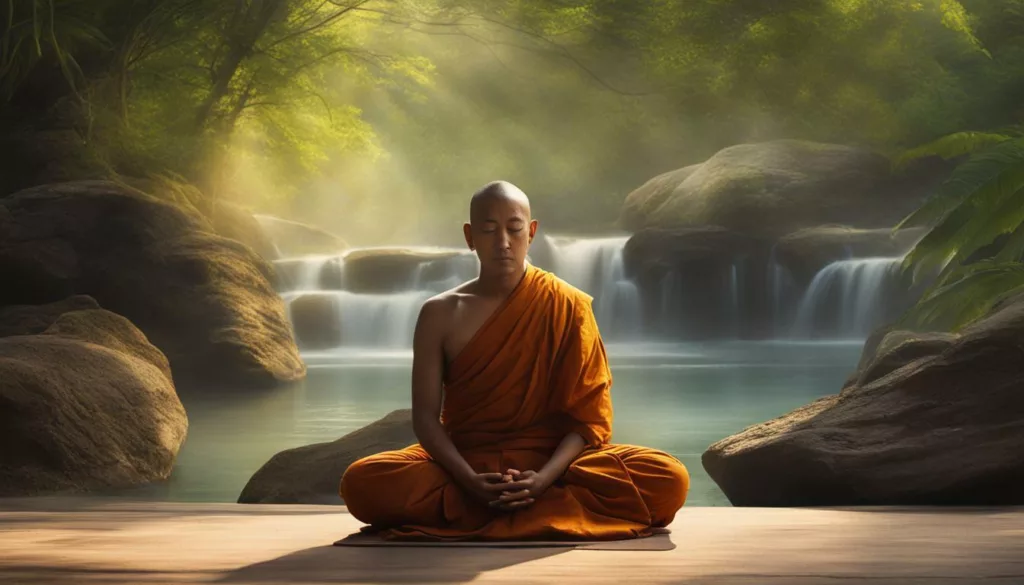Unraveling the Mystery: How Long Do Monks Meditate?
Meditation holds a significant place in the lives of monks, but have you ever wondered how long they actually meditate for? In this article, we will explore the duration of monk meditation sessions and shed light on the practices they engage in.
- Monks engage in a form of meditation called trul-khor, a Tibetan movement practice.
- There are two forms of trul-khor being taught in the West: Yantra Yoga and Trul-Khor.
- These movement practices aim to cultivate a state of “natural mind” and foster a harmonious feeling of oneness with the environment.
- Trul-khor involves a continuous sequence of movement and emphasizes the connection between breath and movement.
- Monks dedicate consistent daily practice to their meditation sessions, highlighting the importance of regularity in their spiritual journey.
Now that we have set the stage, let’s dive deeper into the fascinating world of monk meditation and uncover the secrets behind their tranquil practice.
Understanding the Meditation Practices of Monks
Monks have a range of meditation practices that are an integral part of their daily routine. These practices go beyond simply sitting in stillness and involve various techniques to cultivate mindfulness and inner peace. Let’s explore some of the meditation practices followed by monks and how they structure their meditation schedule.
The Two Forms of Trul-Khor Being Taught in the West
One significant form of meditation practice among monks is trul-khor, a unique Tibetan movement practice. In the West, two forms of trul-khor are being taught: Yantra Yoga and Trul-Khor. Yantra Yoga, taught by Chogyal Namkhai Norbu, consists of 108 movements, while Trul-Khor, taught by Tenzin Wangyal Rinpoche, focuses on 38 movements. Both practices aim to cultivate a state of “natural mind” and foster a harmonious feeling of oneness with the environment.

The Connection Between Breath and Movement
These movement practices emphasize the close connection between breath and movement. With each mindful breath, the practitioners synchronize their movements, creating a continuous flow of motion. The intentional coordination of breath and movement enhances the meditative experience for monks and deepens their connection with their inner selves and the world around them.
The Meditation Schedule for Monks
Monks allocate specific time each day for their meditation practices. Typically, they follow a structured schedule, which may include early morning sessions, breaks for meals and rest, and evening practice. This disciplined approach allows them to maintain consistency and stability in their spiritual journey.
In summary, monks engage in various meditation practices, including the unique movement practice of trul-khor. The connection between breath and movement is a fundamental aspect of these practices, which are designed to cultivate a state of “natural mind” and promote a sense of oneness with the environment. Through their dedicated meditation schedule, monks prioritize inner growth and spiritual development.
Exploring the Length of Monk Meditation Sessions
The length of monk meditation sessions varies, but a consistent daily practice is key to their spiritual journey. Monks engage in a form of meditation called trul-khor, which is a type of Tibetan movement practice. This practice involves a continuous sequence of movement and emphasizes the connection between breath and movement. Trul-khor has two forms being taught in the West: Yantra Yoga and Trul-Khor. Yantra Yoga, taught by Chogyal Namkhai Norbu, consists of 108 movements, while Trul-Khor, taught by Tenzin Wangyal Rinpoche, has 38 movements.
Both Yantra Yoga and Trul-Khor are designed to cultivate a state of “natural mind” and foster a harmonious feeling of oneness with the environment. These movement practices serve as an integral part of the monks’ meditation routine, supporting their spiritual growth and inner peace. By incorporating synchronized breath with mindful movement, monks can deepen their meditative experience and enhance their connection to the present moment.
As monks dedicate themselves to their spiritual path, they prioritize the daily practice of meditation. While the specific length of their meditation sessions may vary, monks devote a significant portion of their day to this practice. The duration of each session depends on individual preferences and the traditions followed by different monastic communities. Some monks may engage in shorter meditation sessions of 20-30 minutes, while others may practice for several hours at a time.
In conclusion, the length of monk meditation sessions varies, but what remains constant is the commitment to a consistent daily practice. Through trul-khor and other forms of meditation, monks continuously cultivate a deeper sense of mindfulness and inner peace, allowing them to navigate their spiritual journey with tranquility and purpose.

| Practice | Number of Movements | Teacher |
|---|---|---|
| Yantra Yoga | 108 | Chogyal Namkhai Norbu |
| Trul-Khor | 38 | Tenzin Wangyal Rinpoche |
Trul-Khor: The Movement Practice of Monks
Monks engage in a distinctive form of meditation known as trul-khor, a Tibetan movement practice that combines breath and movement in a harmonious way. This ancient practice, rooted in Tibetan Buddhism, seeks to cultivate a state of “natural mind” and foster a deep connection with the environment.
In the West, there are two forms of trul-khor that have gained popularity: Yantra Yoga and Trul-Khor. Yantra Yoga, taught by the renowned Chogyal Namkhai Norbu, consists of 108 movements that synchronize breath and movement. Trul-Khor, on the other hand, is taught by Tenzin Wangyal Rinpoche and focuses on 38 movements that promote physical and mental well-being.
These movement practices are not just about physical exercise; they are designed to tap into the inner wisdom and spiritual potential of practitioners. By engaging in a continuous sequence of movements, monks aim to quiet the mind, deepen their self-awareness, and experience a sense of oneness with their surroundings.
One of the core principles of trul-khor is the connection between breath and movement. Practitioners are guided to synchronize their breath with each movement, bringing a heightened sense of mindfulness to their practice. This union of breath and movement allows them to deepen their focus, enhance their body’s energy flow, and enter a state of deep meditation.

| Yantra Yoga | Trul-Khor |
|---|---|
| 108 movements | 38 movements |
| Emphasizes physical flexibility and coordination | Focuses on harmonizing body and mind |
| Taught by Chogyal Namkhai Norbu | Taught by Tenzin Wangyal Rinpoche |
Yantra Yoga and Trul-Khor: Two Forms of Movement Practice
In the West, monks have introduced two forms of trul-khor: Yantra Yoga with 108 movements and Trul-Khor with 38 movements, each taught by esteemed teachers. These movement practices, deeply rooted in Tibetan traditions, offer a unique approach to meditation through the integration of breath and movement. They aim to cultivate a state of “natural mind” and foster a harmonious feeling of oneness with the environment.
Yantra Yoga, taught by Chogyal Namkhai Norbu, consists of 108 movements that are designed to awaken and harmonize the energies within the practitioner’s body and mind. This comprehensive practice combines synchronized breathing techniques with precise physical postures, enabling individuals to experience a deep sense of relaxation and inner balance.
Trul-Khor, taught by Tenzin Wangyal Rinpoche, follows a more condensed approach with 38 movements. It focuses on the connection between breath and movement, emphasizing the synchronization of physical gestures with the inhalation and exhalation patterns. This practice enables practitioners to cultivate mindfulness, enhance their body awareness, and develop a deep sense of presence.

Discovering the Connection Between Breath and Movement
In both Yantra Yoga and Trul-Khor, the connection between breath and movement plays a pivotal role. By synchronizing the breath with specific patterns of body movements, practitioners are able to deepen their meditation experience and create a profound harmony within themselves.
| Movement Practice | Instructor | Number of Movements |
|---|---|---|
| Yantra Yoga | Chogyal Namkhai Norbu | 108 |
| Trul-Khor | Tenzin Wangyal Rinpoche | 38 |
“The integration of breath and movement allows practitioners to enter a state of deep relaxation and mindfulness,” says Chogyal Namkhai Norbu, the renowned instructor of Yantra Yoga. “It is through this connection that we can truly experience the oneness within ourselves and the world around us.”
Whether one chooses to explore Yantra Yoga or Trul-Khor, both movement practices offer an avenue to transcend the limitations of the mind and connect with the present moment. These practices, taught by esteemed teachers, provide individuals with an opportunity to embark on a transformative journey of self-discovery and inner peace.
Cultivating “Natural Mind” through Trul-Khor
Trul-khor practice aims to cultivate a state of “natural mind” and foster a harmonious sense of oneness with the environment, a key aspect of a monk’s serene lifestyle. This form of Tibetan movement practice, which is also known as “magical movements,” involves a continuous sequence of 38 movements. Through the fluid and mindful execution of these movements, practitioners seek to connect with the natural rhythm of their bodies, breath, and surroundings.
In the West, two forms of trul-khor are being taught: Yantra Yoga and Trul-Khor. Yantra Yoga, taught by Chogyal Namkhai Norbu, encompasses 108 movements. It emphasizes the integration of body, breath, and movement, allowing practitioners to develop a deeper connection with their inner selves and the world around them. Trul-Khor, on the other hand, consists of 38 movements and is taught by Tenzin Wangyal Rinpoche. Its focus lies in awakening the subtle energy channels in the body and cultivating a sense of inner balance and presence.
Through the practice of trul-khor, monks aim to evoke a harmonious feeling of oneness with their surroundings. By synchronizing their breath with the fluid movements, they establish a deep connection between body and mind. This connection allows them to tap into a state of heightened awareness, where they can experience a profound sense of tranquility and clarity. Trul-khor serves as a powerful tool in their spiritual journey, enabling them to cultivate the “natural mind” and embody a state of serene mindfulness.

| Form of Trul-Khor | Number of Movements | Teacher |
|---|---|---|
| Yantra Yoga | 108 | Chogyal Namkhai Norbu |
| Trul-Khor | 38 | Tenzin Wangyal Rinpoche |
The Connection Between Breath and Movement in Trul-Khor
The practice of trul-khor emphasizes the inseparable connection between breath and movement, creating a deeply meditative experience for monks. This unique form of Tibetan movement practice involves a continuous sequence of movements, each synchronized with the rhythm of the breath. As monks engage in these fluid movements, they cultivate mindfulness and inner awareness, allowing them to connect with their bodies and the present moment.
Trul-khor consists of two forms that are being taught in the West: Yantra Yoga and Trul-Khor. Yantra Yoga, taught by Chogyal Namkhai Norbu, comprises 108 movements that aim to harmonize body and mind. Trul-Khor, taught by Tenzin Wangyal Rinpoche, focuses on 38 movements that help practitioners develop physical and mental balance. Both forms of trul-khor integrate breath and movement to facilitate a deep meditative state.
“Trul-khor combines the fluidity and grace of movement with the mindfulness of breath,” says Tenzin Wangyal Rinpoche, one of the foremost teachers of this practice. He believes that the synchronization of breath and movement allows practitioners to enter a state of “natural mind,” where the boundaries between body, mind, and environment dissolve, leading to a profound sense of unity.
By aligning breath and movement, trul-khor practitioners harness the power of embodiment. They become attuned to the moment-by-moment sensations in their bodies, cultivating a heightened sense of presence. The harmonious flow of breath and movement serves as a gateway to a deeper meditative experience, helping monks tap into their inner wisdom and connect with the world around them.
Table: Comparison of Yantra Yoga and Trul-Khor
| Practice | Number of Movements | Teacher |
|---|---|---|
| Yantra Yoga | 108 | Chogyal Namkhai Norbu |
| Trul-Khor | 38 | Tenzin Wangyal Rinpoche |
The connection between breath and movement in trul-khor is a fundamental aspect of this practice. By integrating these two elements, monks are able to cultivate a state of mindfulness and unity, experiencing the profound meditative benefits of trul-khor.

Through our exploration, we have discovered the varying durations of monk meditation sessions and the vital role that meditation plays in the lives of monks. Monks engage in a form of meditation called trul-khor, which is a type of Tibetan movement practice. This practice involves a continuous sequence of movement and emphasizes the connection between breath and movement.
There are two forms of trul-khor being taught in the West: Yantra Yoga and Trul-Khor. Yantra Yoga, taught by Chogyal Namkhai Norbu, consists of 108 movements, while Trul-Khor, taught by Tenzin Wangyal Rinpoche, consists of 38 movements. Both forms of trul-khor are designed to cultivate a state of “natural mind,” fostering a harmonious feeling of oneness with the environment.
For monks, daily meditation is an integral part of their tranquil lifestyle. The length of their meditation sessions can vary, but the consistent practice is of utmost importance. As monks engage in trul-khor and other meditation practices, they strive to cultivate a deep connection between their breath and movement, creating a meditative experience that aligns their mind, body, and environment.
In conclusion, the duration of monk meditation sessions can vary, but the essence of their practice lies in the dedication to cultivating a state of “natural mind.” Through the practice of trul-khor and other meditation practices, monks aim to attain a harmonious feeling of oneness and experience the profound benefits that meditation offers.
FAQ
Q: How long do monks meditate?
A: The duration of monk meditation sessions can vary, but on average, monks meditate for several hours each day. Some monks may engage in multiple shorter meditation sessions throughout the day, while others may have longer meditation periods.
Q: What are the meditation practices of monks?
A: Monks follow various meditation practices, including mindfulness meditation, loving-kindness meditation, and vipassana meditation. These practices focus on cultivating a state of deep concentration, inner peace, and self-awareness.
Q: How long do monks meditate each day?
A: Monks dedicate a significant amount of time to daily meditation, often meditating for several hours each day. Consistency in meditation practice is vital in their spiritual journey and the development of mindfulness and clarity of mind.
Q: What is trul-khor?
A: Trul-khor is a unique form of meditation practiced by monks and is a type of Tibetan movement practice. It involves a continuous sequence of movements that emphasize the connection between breath and movement.
Q: What are the two forms of trul-khor taught in the West?
A: In the West, two forms of trul-khor are being taught: Yantra Yoga and Trul-Khor. Yantra Yoga, taught by Chogyal Namkhai Norbu, consists of 108 movements, while Trul-Khor, taught by Tenzin Wangyal Rinpoche, consists of 38 movements.
Q: What is the goal of trul-khor practice?
A: The goal of trul-khor practice is to cultivate a state of “natural mind” and foster a harmonious feeling of oneness with the environment. This practice aligns with the tranquil lifestyle of monks and promotes a deeper connection to oneself and the world around them.
Q: What is the connection between breath and movement in trul-khor?
A: In trul-khor, the connection between breath and movement is emphasized. Synchronized breath and mindful movement help enhance the meditative experience, allowing practitioners to attain a state of deep concentration and presence.






